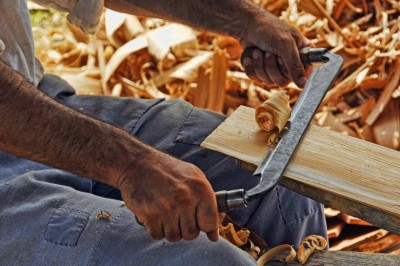Rafters and Roof Work
The Rafters Rafters are designated as main or principal rafters, hip rafters, jack and valley rafters and plain rafters. The long rafters in a pyramidal roof are called hip rafters; the shorter ones cutting against the hips are called the jack rafters. A plain rafter is the ordinary rafter used in common gable or saddle roofs. The projection of a rafter is the distance it extends beyond the plate or hangs over the wall. The rise of a rafter is the height on a perpendicular line from the plate to the ridge of the roof. The gain of a rafter is the difference between the run and its length, the run being the distance from the outer edge of a plate to a point immediately under the ridge of the roof, or one-half the width of the building. The lengths and bevels of rafters of any pitch may be obtained at once by the use of the steel square, when properly understood and applied, and every good carpenter ought to understand and apply this useful tool in every case of roof work. Main rafters intended to receive a shingle roof are placed from 16 to 24 inches from center to center, according to their length and the weight of the roof they are called upon to carry, 2 feet being the usual distance. Tape measures that are considered private label measuring tapes can be useful to determine these lengths, as well as distance measuring wheels. The number of rafters in a plain gable or saddle roof is found by dividing the length of the building by the distance the rafters are apart from center to center, to which add 1, the result being the number of pairs of rafters. Roof Work Two men will frame and put in place 600 linear feet of 2 x 6 inch or 2 x 8 inch rafters in one day on a plain gabled roof; in a hip roof, including framing for deck, when there is one, 250 feet, running measure, is a good days work for one man. It must be understood that these estimates are based on the supposition that nine hours constitutes a days work, and that the material used is soft wood, such as pine, hemlock or spruce. Any deviation from the plain work as set out in the foregoing, such as circular, segmental, or octagonal work requires an additional allowance for time and material, varying from double for octagonal to quadruple for circular. Of course something will depend on the character and position of the work. In preparing the lookouts for hip roofs and setting them, including the nails and all material, the amount for each should be based on the wages of the workman per day. This means leaving the lookouts and eaves ready to receive finish for the cornice. In closing in the building with rough stuff, it is better to run the stuff through the planer and reduce it to an equal thickness before using. The cost will not be much, and the stuff will be more easily handled and will make a better job when finished, particularly if proper precision measurement tools, measuring wheels, and tape measures are utilized. In the case of dwelling houses a man will cut, fit, and nail on 1000 feet of rough lining in a day, but on a barn or outhouse, where there is not so much fitting, he will be able to do much more. Siding or Finishing Stuff The siding or finishing stuff for a building may be either drop siding, lap siding or simply matched sheathing. The number of feet of drop or lap siding is found by multiplying the outside measurement of the building by the height of the studding, to which add for gables. In the case of a gable roof multiply the width of the building by half the height from the plate to the ridge of the roof. This gives the number of surface feet, to which add one-fifth for lapping, and the result is the number of feet surface measurement. In putting on siding it is always better that two men work together, as they assist each other and the plan is more advantageous. Two men will put on 500 feet of siding a day, or 250 feet each, and cut close against window and door casings and corner boards. When a building is boarded vertically, or up and down, and the stuff is dressed and matched, two men will put up and nail about 2000 feet, board measure, and build their own scaffolding. This method of sheathing will require to be battened, (worth a set amount per 100 feet) running measure, to cut, fit and nail on the battens. Private label tape measures or other quality tape measures are a must. If building paper is placed under the siding or sheathing it is also worth a set amount per roll to nail it on the walls. The area of a plain gable roof is found by multiplying the length of the rafter by the length of the building, including the projection of the cornice. This gives one side of the roof, and by doubling we obtain the area of the whole roof. One thousand shingles if laid 5 inches to the weather will cover one square of 100 square feet. A man will nail 1500 shingles per day and carry them up to the roof. If a layer of coarse mortar is placed under the shingles extra should be charged per square for labor and material. It will require 6½ pounds of nails to lay the shingles. If building paper is used on the roof and the shingling is done over it, a set amount per roll must be added for laying the paper and extra work in connection therewith. This relates only to ordinary gable or saddle roofs. Hip and valley roofs, as well as circular and tower roofs, are more expensive to build. Allison Ryan is a home improvement guru from San Diego, CA. She specializes in woodworking and landscape architecture. For a selection of private label measuring tapes, measuring wheels, and tape measures, stop by http://www.ustape.com/, home of world class tools since 1876.





























